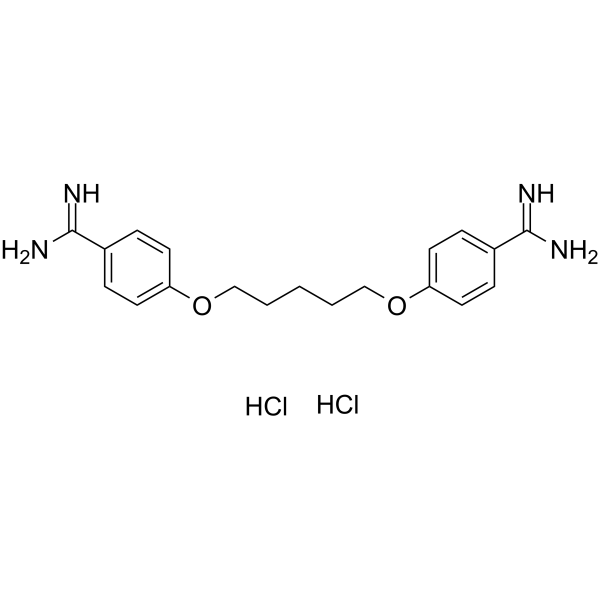
Pentamidine dihydrochloride
CAS No. 50357-45-4
Pentamidine dihydrochloride( MP-601205 dihydrochloride )
Catalog No. M27680 CAS No. 50357-45-4
Pentamidine dihydrochloride is an aromatic diamidine agent with activity against a number of microorganisms including protozoa (Trypanosoma brucei, Leishmania spp., and Babesia spp.) and fungi (Pneumocystis jirovecii).
Purity : >98% (HPLC)
 COA
COA
 Datasheet
Datasheet
 HNMR
HNMR
 HPLC
HPLC
 MSDS
MSDS
 Handing Instructions
Handing Instructions
| Size | Price / USD | Stock | Quantity |
| 5MG | 45 | Get Quote |


|
| 10MG | 68 | Get Quote |


|
| 25MG | 115 | Get Quote |


|
| 50MG | 173 | Get Quote |


|
| 100MG | 258 | Get Quote |


|
| 200MG | 388 | Get Quote |


|
| 500MG | 642 | Get Quote |


|
| 1G | Get Quote | Get Quote |


|
Biological Information
-
Product NamePentamidine dihydrochloride
-
NoteResearch use only, not for human use.
-
Brief DescriptionPentamidine dihydrochloride is an aromatic diamidine agent with activity against a number of microorganisms including protozoa (Trypanosoma brucei, Leishmania spp., and Babesia spp.) and fungi (Pneumocystis jirovecii).
-
DescriptionPentamidine dihydrochloride is an aromatic diamidine agent with activity against a number of microorganisms including protozoa (Trypanosoma brucei, Leishmania spp., and Babesia spp.) and fungi (Pneumocystis jirovecii). Pentamidine dihydrochloride is a potent and selective protein tyrosine phosphatases and phosphatase of regenerating liver inhibitor. Pentamidine dihydrochloride inhibits parasite Leishmania infantum with an IC50 of 2.5 μM.(In Vitro):Pentamidine at its therapeutic doses inhibited recombinant PRL phosphatases in vitro and inactivated ectopically expressed PRLs in NIH3T3 transfectants with an effective duration more than 24 h after a pulse cell treatment.(In Vivo):Pentamidine at a tolerable dose markedly inhibited the growth of WM9 human melanoma tumors in nude mice coincident with the induction of tumor cell necrosis and is capable of inactivating ectopically expressed PRL-2 in the cancer cells.
-
In VitroPentamidine (0-10 μg/mL; 6 days; WM9, DU145, C4-2, Hey, WM480, and A549 cells) treatment inhibits the growth of cancer cells in a concentration-dependent manner.The cytotoxic properties of Pentamidine isethionate towards the promastigotes of the protozoan parasite Leishmania infantum is determined. The leishmanicidal activity of Pentamidine isethionate is 60 times higher after 72 h of incubation than that of Cisplatin. Pentamidine isethionate induces a higher amount of programmed cell death (PCD) than Cisplatin, which is associated with inhibition of DNA synthesis and cell-cycle arrest in the G2/M phase. Binding of Pentamidine isethionate to calf-thymus DNA (CT-DNA) induces conformational changes in the DNA double helix, consistent with a B-->A transition. The interaction of Pentamidine isethionate with ubiquitin leads to a 6% increase in the beta-sheet content of the protein. Cell Viability Assay Cell Line:WM9, DU145, C4-2, Hey, WM480, and A549 cells Concentration:0-10 μg/mL Incubation Time:6 days Result:The growth of all six of the cell lines in culture was inhibited in a concentration-dependent manner with complete growth inhibition of the cell lines occurring at 10 μg/mL.
-
In VivoPentamidine (0.25 mg/mouse; intramuscular injection; every 2 days; for 4 weeks; athymic nude mice) treatment markedly inhibits the growth of WM9 human melanoma tumors in nude mice. Animal Model:Athymic nude mice (6 weeks old) injected with WM9 cells Dosage:0.25 mg/mouse Administration:Intramuscular injection; every 2 days; for 4 weeks Result:Markedly inhibited the growth of WM9 human melanoma tumors in nude mice.
-
SynonymsMP-601205 dihydrochloride
-
PathwayMetabolic Enzyme/Protease
-
TargetPhosphatase
-
Recptoraryl hydrocarbon receptor|GSK-3|CDK1/CyclinB|CDK5/p25
-
Research Area——
-
Indication——
Chemical Information
-
CAS Number50357-45-4
-
Formula Weight413.34
-
Molecular FormulaC19H26Cl2N4O2
-
Purity>98% (HPLC)
-
Solubility——
-
SMILES[Cl-].[Cl-].NC(=[NH2+])c1ccc(OCCCCCOc2ccc(cc2)C(N)=[NH2+])cc1
-
Chemical Name——
Shipping & Storage Information
-
Storage(-20℃)
-
ShippingWith Ice Pack
-
Stability≥ 2 years
Reference
1.Meijer L, et al. GSK-3-selective inhibitors derived from Tyrian purple indirubins. Chem Biol. 2003 Dec;10(12):1255-66.
molnova catalog



related products
-
SHP099 monohydrochlo...
SHP099 is a potent, selective, orally bioavailable, and efficacious SHP2 inhibitor.
-
h-NTPDase8-IN-1
h-NTPDase8-IN-1 is a specific aminosulfonylbenzamide inhibitor of h-NTPDases8 (IC 50 = 0.28 ± 0.07 μM). h-NTPDase8-IN-1 can be used to study diseases brought about by aberrant h -NTPDase expression.
-
Raphin1 acetate
Raphin1 acetate is a selective and orally bioavailable regulatory phosphatase PPP1R15B (R15B) inhibitor.Raphin1, a selective inhibitor of R15B.?In cells, Raphin1 caused a rapid and transient accumulation of its phosphorylated substrate, resulting in a transient attenuation of protein synthesis.?



 Cart
Cart
 sales@molnova.com
sales@molnova.com


